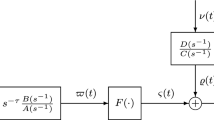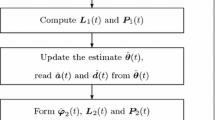Abstract
This paper addresses the problem of recursive identification of Wiener nonlinear systems whose linear subsystems are observable state-space models. The maximum likelihood principle and the recursive identification technique are employed to develop a recursive maximum likelihood identification algorithm which estimates the unknown parameters and the system states interactively. In comparison with the developed recursive maximum likelihood algorithm, a recursive generalized least squares algorithm is also proposed for identification of such Wiener systems. The performance of the developed algorithms is validated by two illustrative examples.






Similar content being viewed by others
References
S.I. Biagiola, J.L. Figueroa, Identification of uncertain MIMO Wiener and Hammerstein models. Comput. Chem. Eng. 35(12), 2867–2875 (2011)
F. Ding, Combined state and least squares parameter estimation algorithms for dynamic systems. Appl. Math. Model. 38(1), 403–412 (2014)
F. Ding, L. Xu, Q.M. Zhu, Performance analysis of the generalised projection identification for time-varying systems. IET Control Theory Appl. 10(18), 2506–2514 (2016)
F. Ding, X.H. Wang, L. Mao, L. Xu, Joint state and multi-innovation parameter estimation for time-delay linear systems and its convergence based on the Kalman filtering. Digit. Signal Process. 62, 211–223 (2017)
F. Ding, F.F. Wang, L. Xu, M.H. Wu, Decomposition based least squares iterative identification algorithm for multivariate pseudo-linear ARMA systems using the data filtering. J. Frankl. Inst. 354(3), 1321–1339 (2017)
F. Ding, F.F. Wang, T. Hayat, A. Alsaedi, Parameter estimation for pseudo-linear systems using the auxiliary model and the decomposition technique. IET Control Theory Appl. 11(3), 390–400 (2017)
W. Favoreel, B. De Moor, P.V. Overschee, Subspace state space system identification for industrial processes. J. Process Control 10(2–3), 149–155 (2000)
J.C. Gómez, E. Baeyens, Identification of block-oriented nonlinear systems using orthonormal bases. J. Process Control 14(6), 685–697 (2004)
W. Greblicki, Nonparametric approach to Wiener system identification. IEEE Trans. Circuits Syst. I Fundam. Theory Appl. 44(6), 538–545 (1997)
Y. Gu, X. Lu, R. Ding, Parameter and state estimation algorithm for a state space model with a one-unit state delay. Circuits Syst. Signal Process. 32(5), 2267–2280 (2013)
J. Guo, L.Y. Wang, G. Yin, Y.L. Zhao, J.F. Zhang, Identification of Wiener systems with quantized inputs and binary-valued output observations. Automatica 78, 280–286 (2017)
G. Li, C. Wen, W.X. Zheng, Y. Chen, Identification of a class of nonlinear autoregressive models with exogenous inputs based on kernel machines. IEEE Trans. Signal Process. 59(5), 2146–2159 (2011)
J.H. Li, F. Ding, G.W. Yang, Maximum likelihood least squares identification method for input nonlinear finite impulse response moving average systems. Math. Comput. Model. 55(3–4), 442–450 (2012)
J.H. Li, F. Ding, L. Hua, Maximum likelihood Newton recursive and the Newton iterative estimation algorithms for Hammerstein CARAR systems. Nonlinear Dyn. 75(1–2), 235–245 (2014)
J.H. Li, W.X. Zheng, J.P. Gu, L. Hua, Parameter estimation algorithms for Hammerstein output error systems using Levenberg–Marquardt optimization method with varying interval measurements. J. Frankl. Inst. 354(1), 316–331 (2017)
L. Ljung, System Identification: Theory for the User, 2nd edn. (Prentice Hall, Englewood Cliffs, New Jersey, 1999)
M. Lovera, T. Gustafsson, M. Verhaegen, Recursive subspace identification of linear and non-linear Wiener state-space models. Automatica 36(11), 1639–1650 (2000)
G. Mercère, L. Bako, Parameterization and identification of multivariable state-space systems: a canonical approach. Automatica 47(8), 1547–1555 (2011)
G. Mzyk, P. Wachel, Kernel-based identification of Wiener–Hammerstein system. Automatica 83, 275–281 (2017)
R.D. Nowak, Nonlinear system identification. Circuits Syst. Signal Process. 21(1), 109–122 (2005)
S. Oblak, I. Škrjanc, Continuous-time Wiener-model predictive control of a pH process based on a PWL approximation. Chem. Eng. Sci. 65(5), 1720–1728 (2010)
J. Pan, X. Jiang, X.K. Wan, W. Ding, A filtering based multi-innovation extended stochastic gradient algorithm for multivariable control systems. Int. J. Control Autom. Syst. 15(3), 1189–1197 (2017)
T.B. Schön, A. Wills, B. Ninness, System identification of nonlinear state-space models. Automatica 47(1), 39–49 (2011)
G. Shafiee, M.M. Arefi, M.R. Jahed-Motlagh, A.A. Jalali, Nonlinear predictive control of a polymerization reactor based on piecewise linear Wiener model. Chem. Eng. J. 143(1–3), 282–292 (2008)
Y. Shi, J.H. Qin, H.S. Ahn, Distributed coordination control and industrial applications. IEEE Trans. Ind. Electron. 64(6), 4967–4971 (2017)
J. Sjöberg, Q.H. Zhang, L. Ljung, A. Benveniste, B. Delyon, P.-Y. Glorennec, H. Hjalmarsson, A. Juditsk, Nonlinear black-box modeling in system identification: a unified overview. Automatica 31(12), 1691–1724 (1995)
T. Söderström, U. Soverini, Errors-in-variables identification using maximum likelihood estimation in the frequency domain. Automatica 79, 131–143 (2017)
K. Tiels, J. Schoukens, Wiener system identification with generalized orthonormal basis functions. Automatica 50(12), 3147–3154 (2014)
D.Q. Wang, Y.P. Gao, Recursive maximum likelihood identification method for a multivariable controlled autoregressive moving average system. IMA J. Math. Control Inf. 33(4), 1015–1031 (2016)
D.Q. Wang, Z. Zhang, J.Y. Yuan, Maximum likelihood estimation method for dual-rate Hammerstein systems. Int. J. Control Autom. Syst. 15(2), 698–705 (2017)
X.H. Wang, F. Ding, Joint estimation of states and parameters for an input nonlinear state-space system with colored noise using the filtering technique. Circuits Syst. Signal Process. 35(2), 481–500 (2016)
X.H. Wang, F. Ding, Convergence of the recursive identification algorithms for multivariate pseudo-linear regressive systems. Int. J. Adapt. Control Signal Process. 30(6), 824–842 (2016)
D. Westwick, M. Verhaegen, Identifying MIMO Wiener systems using subspace model identification methods. Signal Process. 52(2), 235–258 (1996)
F. Yu, Z.Z. Mao, M.X. Jia, Recursive identification for Hammerstein–Wiener systems with dead-zone input nonlinearity. J. Process Control 23(8), 1108–1115 (2013)
L. Xu, F. Ding, Recursive least squares and multi-innovation stochastic gradient parameter estimation methods for signal modeling. Circuits Syst. Signal Process. 36(4), 1735–1753 (2017)
L. Xu, F. Ding, Y. Gu, A. Alsaedi, T. Hayat, A multi-innovation state and parameter estimation algorithm for a state space system with d-step state-delay. Signal Process. 140, 97–103 (2017)
W.X. Zhao, H.F. Chen, W.X. Zheng, Recursive identification for nonlinear ARX systems based on stochastic approximation algorithm. IEEE Trans. Autom. Control 55(6), 1287–1299 (2010)
W.X. Zhao, W.X. Zheng, E.-W. Bai, A recursive local linear estimator for identification of nonlinear ARX systems: Asymptotical convergence and applications. IEEE Trans. Autom. Control 58(12), 3054–3069 (2013)
Acknowledgements
This work was supported in part by the National Natural Science Foundation of China (61403217, 61273024), the Jiangsu Province Postdoctoral Research Funding Plan (1601129B), the Jiangsu Government Scholarship for Overseas Studies, and the Australian Research Council (DP120104986).
Author information
Authors and Affiliations
Corresponding author
Rights and permissions
About this article
Cite this article
Li, J., Zheng, W.X., Gu, J. et al. A Recursive Identification Algorithm for Wiener Nonlinear Systems with Linear State-Space Subsystem. Circuits Syst Signal Process 37, 2374–2393 (2018). https://doi.org/10.1007/s00034-017-0682-7
Received:
Revised:
Accepted:
Published:
Issue Date:
DOI: https://doi.org/10.1007/s00034-017-0682-7




